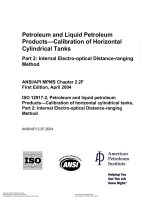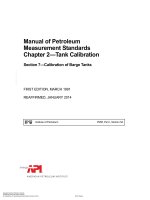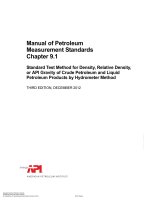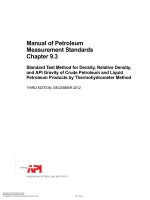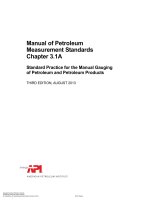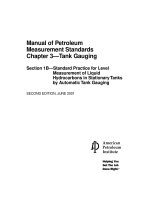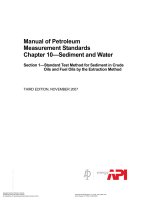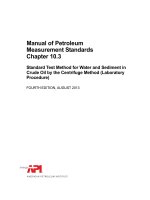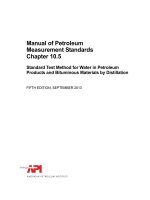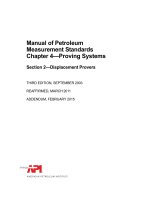Api mpms 2 2g 2014 (american petroleum institute)
Bạn đang xem bản rút gọn của tài liệu. Xem và tải ngay bản đầy đủ của tài liệu tại đây (375.6 KB, 24 trang )
Manual of Petroleum
Measurement Standards
Chapter 2.2G
Calibration of Upright Cylindrical Tanks Using the
Total Station Reference Line Method
FIRST EDITION, JULY 2014
Copyright American Petroleum Institute
Provided by IHS under license with API
No reproduction or networking permitted without license from IHS
Special Notes
API publications necessarily address problems of a general nature. With respect to particular circumstances, local,
state, and federal laws and regulations should be reviewed.
Neither API nor any of API's employees, subcontractors, consultants, committees, or other assignees make any
warranty or representation, either express or implied, with respect to the accuracy, completeness, or usefulness of the
information contained herein, or assume any liability or responsibility for any use, or the results of such use, of any
information or process disclosed in this publication. Neither API nor any of API's employees, subcontractors,
consultants, or other assignees represent that use of this publication would not infringe upon privately owned rights.
Users of this standard should not rely exclusively on the information contained in this document. Sound business,
scientific, engineering, and safety judgment should be used in employing the information contained herein.
API publications may be used by anyone desiring to do so. Every effort has been made by the Institute to assure the
accuracy and reliability of the data contained in them; however, the Institute makes no representation, warranty, or
guarantee in connection with this publication and hereby expressly disclaims any liability or responsibility for loss or
damage resulting from its use or for the violation of any authorities having jurisdiction with which this publication may
conflict.
API publications are published to facilitate the broad availability of proven, sound engineering and operating
practices. These publications are not intended to obviate the need for applying sound engineering judgment
regarding when and where these publications should be utilized. The formulation and publication of API publications
is not intended in any way to inhibit anyone from using any other practices.
Any manufacturer marking equipment or materials in conformance with the marking requirements of an API standard
is solely responsible for complying with all the applicable requirements of that standard. API does not represent,
warrant, or guarantee that such products do in fact conform to the applicable API standard.
All rights reserved. No part of this work may be reproduced, translated, stored in a retrieval system, or transmitted by any means,
electronic, mechanical, photocopying, recording, or otherwise, without prior written permission from the publisher. Contact the
Publisher, API Publishing Services, 1220 L Street, NW, Washington, DC 20005.
Copyright © 2014 American Petroleum Institute
Copyright American Petroleum Institute
Provided by IHS under license with API
No reproduction or networking permitted without license from IHS
Foreword
Chapter 2.2G of the Manual of Petroleum Measurement Standards should be used in conjunction with API MPMS
Chapter 2.2A, Measurement and Calibration of Upright Cylindrical Tanks by the Manual Tank Strapping Method. Units
of measure in this publication are in International System (SI) and U.S. customary (USC) units consistent with North
American industry practices.
Shall: As used in a standard, “shall” denotes a minimum requirement in order to conform to the specification.
Should: As used in a standard, “should” denotes a recommendation or that which is advised but not required in order
to conform to the specification.
Nothing contained in any API publication is to be construed as granting any right, by implication or otherwise, for the
manufacture, sale, or use of any method, apparatus, or product covered by letters patent. Neither should anything
contained in the publication be construed as insuring anyone against liability for infringement of letters patent.
This document was produced under API standardization procedures that ensure appropriate notification and
participation in the developmental process and is designated as an API standard. Questions concerning the
interpretation of the content of this publication or comments and questions concerning the procedures under which
this publication was developed should be directed in writing to the Director of Standards, American Petroleum
Institute, 1220 L Street, NW, Washington, DC 20005. Requests for permission to reproduce or translate all or any part
of the material published herein should also be addressed to the director.
Generally, API standards are reviewed and revised, reaffirmed, or withdrawn at least every five years. A one-time
extension of up to two years may be added to this review cycle. Status of the publication can be ascertained from the
API Standards Department, telephone (202) 682-8000. A catalog of API publications and materials is published
annually by API, 1220 L Street, NW, Washington, DC 20005.
Suggested revisions are invited and should be submitted to the Standards Department, API, 1220 L Street, NW,
Washington, DC 20005,
iii
Copyright American Petroleum Institute
Provided by IHS under license with API
No reproduction or networking permitted without license from IHS
Copyright American Petroleum Institute
Provided by IHS under license with API
No reproduction or networking permitted without license from IHS
Contents
Page
1
Scope . . . . . . . . . . . . . . . . . . . . . . . . . . . . . . . . . . . . . . . . . . . . . . . . . . . . . . . . . . . . . . . . . . . . . . . . . . . . . . . . . . 1
2
Normative References. . . . . . . . . . . . . . . . . . . . . . . . . . . . . . . . . . . . . . . . . . . . . . . . . . . . . . . . . . . . . . . . . . . . . 1
3
Terms and Definitions . . . . . . . . . . . . . . . . . . . . . . . . . . . . . . . . . . . . . . . . . . . . . . . . . . . . . . . . . . . . . . . . . . . . . 1
4
Application of the Total Station Reference Line Method. . . . . . . . . . . . . . . . . . . . . . . . . . . . . . . . . . . . . . . . . 1
5
Electro-optical Device General Requirements . . . . . . . . . . . . . . . . . . . . . . . . . . . . . . . . . . . . . . . . . . . . . . . . . 1
6
Electro-optical Device Calibration and Recalibration . . . . . . . . . . . . . . . . . . . . . . . . . . . . . . . . . . . . . . . . . . . 2
7
7.1
7.2
7.3
Electro-optical Device Field Verification. . . . . . . . . . . . . . . . . . . . . . . . . . . . . . . . . . . . . . . . . . . . . . . . . . . . . .
Field Verification . . . . . . . . . . . . . . . . . . . . . . . . . . . . . . . . . . . . . . . . . . . . . . . . . . . . . . . . . . . . . . . . . . . . . . . . .
Verification Procedure . . . . . . . . . . . . . . . . . . . . . . . . . . . . . . . . . . . . . . . . . . . . . . . . . . . . . . . . . . . . . . . . . . . .
Acceptability Criteria. . . . . . . . . . . . . . . . . . . . . . . . . . . . . . . . . . . . . . . . . . . . . . . . . . . . . . . . . . . . . . . . . . . . . .
2
2
2
4
8
8.1
8.2
8.3
8.4
8.5
Electro-optical Device Field Setup Procedure . . . . . . . . . . . . . . . . . . . . . . . . . . . . . . . . . . . . . . . . . . . . . . . . .
General . . . . . . . . . . . . . . . . . . . . . . . . . . . . . . . . . . . . . . . . . . . . . . . . . . . . . . . . . . . . . . . . . . . . . . . . . . . . . . . . .
Horizontal and Vertical Stations. . . . . . . . . . . . . . . . . . . . . . . . . . . . . . . . . . . . . . . . . . . . . . . . . . . . . . . . . . . . .
Horizontal Station Setup . . . . . . . . . . . . . . . . . . . . . . . . . . . . . . . . . . . . . . . . . . . . . . . . . . . . . . . . . . . . . . . . . . .
Instrument Setup for Vertical Stations at Horizontal Station . . . . . . . . . . . . . . . . . . . . . . . . . . . . . . . . . . . . .
Electro-optical Device Stability . . . . . . . . . . . . . . . . . . . . . . . . . . . . . . . . . . . . . . . . . . . . . . . . . . . . . . . . . . . . .
4
4
4
4
5
5
9
9.1
9.2
9.3
9.4
9.5
Measurements . . . . . . . . . . . . . . . . . . . . . . . . . . . . . . . . . . . . . . . . . . . . . . . . . . . . . . . . . . . . . . . . . . . . . . . . . . .
Master Tape . . . . . . . . . . . . . . . . . . . . . . . . . . . . . . . . . . . . . . . . . . . . . . . . . . . . . . . . . . . . . . . . . . . . . . . . . . . . .
Master Working Tape . . . . . . . . . . . . . . . . . . . . . . . . . . . . . . . . . . . . . . . . . . . . . . . . . . . . . . . . . . . . . . . . . . . . .
Working Tape . . . . . . . . . . . . . . . . . . . . . . . . . . . . . . . . . . . . . . . . . . . . . . . . . . . . . . . . . . . . . . . . . . . . . . . . . . . .
Reference Circumference. . . . . . . . . . . . . . . . . . . . . . . . . . . . . . . . . . . . . . . . . . . . . . . . . . . . . . . . . . . . . . . . . .
Distance and Angular Measurements . . . . . . . . . . . . . . . . . . . . . . . . . . . . . . . . . . . . . . . . . . . . . . . . . . . . . . . .
5
5
6
6
7
9
10
Computation of Course Diameters . . . . . . . . . . . . . . . . . . . . . . . . . . . . . . . . . . . . . . . . . . . . . . . . . . . . . . . . . . 9
11
Development of the Capacity Table. . . . . . . . . . . . . . . . . . . . . . . . . . . . . . . . . . . . . . . . . . . . . . . . . . . . . . . . . 10
Tables
1
Number of Horizontal Stations. . . . . . . . . . . . . . . . . . . . . . . . . . . . . . . . . . . . . . . . . . . . . . . . . . . . . . . . . . . . . . 4
2
Reference Circumference Tolerances (Soft Conversions) . . . . . . . . . . . . . . . . . . . . . . . . . . . . . . . . . . . . . . . 9
Figures
1
TSRLM Device Verification at Site: Stadia Horizontal . . . . . . . . . . . . . . . . . . . . . . . . . . . . . . . . . . . . . . . . . .
2
TSRLM Device Verification at Site: Stadia Vertical . . . . . . . . . . . . . . . . . . . . . . . . . . . . . . . . . . . . . . . . . . . .
3
Distance and Vertical Angle . . . . . . . . . . . . . . . . . . . . . . . . . . . . . . . . . . . . . . . . . . . . . . . . . . . . . . . . . . . . . . .
4
Setting Location of Vertical Station Tangential Traverse Method . . . . . . . . . . . . . . . . . . . . . . . . . . . . . . .
v
Copyright American Petroleum Institute
Provided by IHS under license with API
No reproduction or networking permitted without license from IHS
11
12
13
14
Copyright American Petroleum Institute
Provided by IHS under license with API
No reproduction or networking permitted without license from IHS
Introduction
The Total Station Reference Line Method (TSRLM) is an alternative to the Manual Tank Strapping Method (MTSM) for
determining tank diameter. The primary difference between TSRLM and MTSM is the procedure for determining tank
diameter at shell courses other than the bottom course. TSRLM requires measuring a reference circumference on the
bottom course by manual strapping with a tape that is traceable to the National Institute of Standards and Technology
(NIST) or other national metrology institute. The other required special measurements, procedures, methods, and
analytical tools for the development of a tank capacity table are identical to those stated in API MPMS Chapter 2.2A.
In addition, TSRLM requires the measurement of deviations in tank diameter at other predetermined horizontal and
vertical stations by using a total station electro-optical device.
This method eliminates the use of a magnetic trolley that is required in the external Optical Reference Line Method
(ORLM, reference API MPMS Chapter 2.2B) for the calibration of upright cylindrical tanks; thus, it provides significant
safety enhancements by being able to do all the offset measurement work from ground level.
vii
Copyright American Petroleum Institute
Provided by IHS under license with API
No reproduction or networking permitted without license from IHS
Copyright American Petroleum Institute
Provided by IHS under license with API
No reproduction or networking permitted without license from IHS
Calibration of Upright Cylindrical Tanks Using the
Total Station Reference Line Method
1 Scope
This standard describes measurement and calculation procedures for determining the diameters of upright
cylindrical tanks by taking vertical offset measurements externally using Electro-optical Distance Ranging
(EODR) equipment rather than conventional ORLM plummet/trolley equipment. This standard is an alternate
standard to API MPMS Ch. 2.2B. This standard is used in conjunction with API MPMS Ch. 2.2A. Calibration
of insulated tanks is covered by API MPMS Ch. 2.2D. Abnormally deformed tanks that are dented or have
other visible signs of damage are not covered by this standard.
2 Normative References
The following referenced documents are indispensable for the application of this document. For dated
references, only the edition cited applies. For undated references, the latest edition of the referenced
document (including any amendments) applies.
API Manual of Petroleum Measurement Standards (MPMS), Chapter 2.2A, Measurement and Calibration of
Upright Cylindrical Tanks by the Manual Tank Strapping Method
3 Terms and Definitions
For the purposes of this document, the following terms and definitions apply. Terms of more general use may
be found in the API MPMS Chapter 1 Online Terms and Definitions Database.
3.1
horizontal station
Preestablished location in the horizontal plane at ground level along the tank circumference.
3.2
slope distance
Distance measured from an EODR instrument to a vertical station on the tank.
3.3
vertical station
Preestablished location in the vertical plane along the tank shell, corresponding to a given horizontal station.
4 Application of the Total Station Reference Line Method
This method is for the external calibration of upright cylindrical tanks. For tanks that are insulated, the
insulation shall be removed for application of this method, or the calibration may be undertaken internally per
API MPMS Ch. 2.2D.
5 Electro-optical Device General Requirements
The total station instrument should preferably have a locking device, the objective being to keep the
horizontal angle constant while vertical station measurements are taken at any given horizontal station.
The electro-optical device shall be capable of reading distances to within 2 mm and angles to within 5 sec or
better.
For the proper operation of the electro-optical device being used, follow manufacturer’s instructions.
1
Copyright American Petroleum Institute
Provided by IHS under license with API
No reproduction or networking permitted without license from IHS
2
API MPMS CHAPTER 2.2G
6 Electro-optical Device Calibration and Recalibration
The electro-optical device shall carry a certificate of calibration that is traceable to the national reference
standard. The factory calibration is acceptable provided that it carries traceability.
The calibration certificate shall be renewed at a set frequency depending on the usage of the device that
should be established based on the observed drift from base calibration. In any case the recalibration shall
be undertaken at least once every 12 months.
The certificate should carry residual uncertainty associated with distance and the angle (vertical and
horizontal) as well as the drift in these parameters prior to calibration.
7 Electro-optical Device Field Verification
7.1
Field Verification
The term verification involves checking that the angle and the distance the device measures are within
acceptable limits. Such verification should be carried out using a stadia at each site at least once prior to the
start of the actual tank calibration. See Figure 1 and Figure 2.
A stadia is a graduated rod, 2 m in length between two marks. It may be made of a nickel ferrous alloy
(NiFe), or other suitable material, with a thermal linear coefficient of 0.0000008 in./in. F.
Alternately, a steel rod of equivalent length, measured with a master tape at the prescribed tension, and
compensated for ambient temperature, may be used.
7.2
Verification Procedure
The verification procedure is as follows.
1) Position the stadia at Location 1, approximately 10 ft away from the electro-optical device.
2) Put the stadia in an approximately horizontal orientation as in Figure 1.
3) Measure slope distance from the electro-optical device to stadia Target Point 1 (TP 1).
4) Measure slope distance from the electro-optical device to stadia Target Point 2 (TP 2).
5) Record the sweep angle (β) between TP1 and TP2 and calculate the theoretical length of the stadia
using Equation (1).
6) Record the X, Y, and Z coordinates for TP1 and TP2 and calculate the theoretical length of the stadia
using Equation (3).
7) Compare the theoretical length to its known value and determine its acceptability, as illustrated in 7.3.
8) Put the stadia in an approximately vertical orientation as in Figure 2.
9) Measure slope distance from the electro-optical device to stadia Target Point 3 (TP 3).
10) Measure slope distance from the electro-optical device to stadia Target Point 4 (TP 4).
11) Record the sweep angle (θ) between TP3 and TP4 and calculate the theoretical length of the stadia
using Equation (2).
Copyright American Petroleum Institute
Provided by IHS under license with API
No reproduction or networking permitted without license from IHS
CALIBRATION OF UPRIGHT CYLINDRICAL TANKS USING THE TOTAL STATION REFERENCE LINE METHOD
3
12) Record the X, Y, and Z coordinates for TP3 and TP4 and calculate the theoretical length of the stadia
using Equation (4).
13) Compare the theoretical length to its known value and determine its acceptability as illustrated in 7.3.
14) Position the stadia at Location 2, approximately 20 ft away from the electro-optical device.
15) Repeat Steps 2 through 13 for stadia Location 2.
Acceptability calculations using the sweep angle that is not necessarily vertical or horizontal:
c=
(a
2
+ b 2 − 2ab × cos β
)
(1)
where
a
is the lope distance from electro-optical instrument to stadia TP 1;
b
is the slope distance from electro-optical instrument to stadia TP 2;
c
is the computed theoretical length of the stadia or theoretical compensated master tape length;
β
is the angle described by sides “a” and “b” to TP 1 and TP 2.
f =
(d
2
+ e 2 − 2de × cos θ
)
(2)
where
d
is the slope distance from electro-optical instrument to stadia TP 3;
e
is the slope distance from electro-optical instrument to stadia TP 4;
f
is the computed theoretical length of the stadia or theoretical compensated master tape length;
θ
is the angle described by sides “d” and “e” to TP 3 and TP 4.
Acceptability calculations using the polar coordinates:
c = ( x1 − x 2 ) 2 + ( y1 − y 2 ) 2 + ( z 1 − z 2 ) 2
(3)
where
x1, x 2 , y 1, y 2 , z 1, and z 2 are the polar coordinates for TP1 and TP2.
f = (x3 − x 4 ) 2 + ( y 3 − y 4 ) 2 + (z 3 − z 4 ) 2
where
x 3 , x 4 , y 3 , y 4 , z 3 , and z 4 are the polar coordinates for TP3 and TP4.
Copyright American Petroleum Institute
Provided by IHS under license with API
No reproduction or networking permitted without license from IHS
(4)
4
7.3
API MPMS CHAPTER 2.2G
Acceptability Criteria
The computed theoretical length (combining the effects of both lengths and angles) of the stadia, or
theoretical compensated master tape length, shall be within 2 mm of its known value.
If the verification procedure fails to meet the criteria, the electro-optical instrument shall be recalibrated.
8 Electro-optical Device Field Setup Procedure
8.1
General
The electro-optical device is set up, perpendicular to the shell of the tank, at a predetermined number of
equidistant horizontal stations. At each horizontal station, the slope distance is measured to each of the
predetermined vertical station points as well as the adjacent vertical angles. The horizontal distances are
calculated from the shell of the tank to the intersection of the vertical zenith-nadir line at the electro-optical
device.
8.2
Horizontal and Vertical Stations
The number of horizontal stations (NH) is a function of tank diameter as per the following table:
Table 1—Number of Horizontal Stations
Diameter
ft
NH
50
8
100
12
150
16
200
20
250
24
300
30
The position of vertical stations (NV) is presented in Figure 3. The bottom course should have one vertical
station at approximately 20 % to 25 % below the top horizontal ring seam. All other rings have two vertical
stations. One is approximately 20 % to 25 % above the bottom ring seam and the other is approximately
20 % to 25 % below the top ring seam.
8.3
Horizontal Station Setup
In accordance with Table 1, the horizontal stations are located in an approximate equidistant manner around
the tank. Horizontal station 1 is normally located in line with the gauge hatch.
Horizontal stations shall be chosen to ensure that all slope measurements are taken at least 12 in. (300 mm)
away from any vertical seam.
The preferred vertical angle (α) as presented in Figure 3 should be between 45 and 60, away from the
horizontal at the top most vertical station of the course. Knowing the vertical height (VH) it is possible to set
the electro-optical device at a horizontal distance (HD) away from the tank between (VH/tan 60) and (VH/tan
45), or simply VH.
Copyright American Petroleum Institute
Provided by IHS under license with API
No reproduction or networking permitted without license from IHS
CALIBRATION OF UPRIGHT CYLINDRICAL TANKS USING THE TOTAL STATION REFERENCE LINE METHOD
5
It should be noted that the horizontal distance need not be the same for all horizontal stations. They can
vary, but it is preferable to maintain the vertical angle always between 45 and 60 in all cases.
8.4
Instrument Setup for Vertical Stations at Horizontal Station
At any given horizontal station, it is necessary to measure the distance from the horizontal station to the
vertical stations on the courses. To target exactly the perpendicular point of vertical station on any given
course, the following Tangential Traverse Method is recommended.
Aim the optical device approximately perpendicular to the tank and note the vertical angle.
While keeping the vertical angle constant, as illustrated in Figure 4, set the electro-optical device to the
tangent point “A” on the left side of the tank, and note the horizontal angle on the electro-optical device. Then
move the device to the tangent point “B” on the right side by traversing the tank in a clockwise direction,
while continuing to keep the vertical angle constant. Note the horizontal angle on the electro-optical device.
The net angle between the tangents (Φ) is computed as the difference between the two observed angles.
Compute the vertical station set point by adding or subtracting the angle (Φ/2) to the observed angle on the
electro-optical device. Set the electro-optical device to this angle that locates the vertical station point on the
course; and this ensures that the optical device is perpendicular to the tank at that point.
Once the reference vertical station point is located on the bottom course, if a horizontal locking device is
available on the electro-optical unit, the unit may be locked in position but free to traverse vertically, thus
scanning all vertical stations.
If no horizontal locking device is available, repeat the Tangential Traverse Method on each of the courses
and at each level (approximately 20 % to 25 % above and below the horizontal seams) to set the target
vertical station points.
If obstructions are encountered when setting up a horizontal station, an adjustment may be made in the
location of the horizontal station. In that case, the tangential traverse procedure shall be repeated.
8.5
Electro-optical Device Stability
The device has to be stable and level in a horizontal plane. Hence, undertaking calibration under windy,
rainy, and wet soil conditions, the stability of the device may be questionable, and thus it is not
recommended to undertake a tank calibration under these conditions.
Also, it is very important to ensure that there are no sources of vibration close by. This is to make sure that
measurements are undertaken under vibration-free conditions.
Additional checks as detailed below will be required during the process of taking field measurements.
9 Measurements
9.1
Master Tape
A master tape, 100 ft in length, has a Report of Calibration from the National Institute of Standards and
Technology (NIST) or other National Metrology Institute. It has been calibrated in 25 ft increments from 25 ft
through 100 ft at one or more specified tensions, such as 10 lb, and mathematically adjusted to a specified
temperature such as 68 F. The NIST Report of Calibration also provides the coefficient of linear thermal
expansion per degree Fahrenheit for the steel used in the tape. A copy of its report of calibration should
always accompany the master tape.
Copyright American Petroleum Institute
Provided by IHS under license with API
No reproduction or networking permitted without license from IHS
6
API MPMS CHAPTER 2.2G
A master tape can be used as the primary field standard for measuring reference circumferences, or it can
be used to calibrate master and field working tapes. In order for it to qualify as a master tape:
a) it shall not have kinks or suffered other significant damage,
b) it shall not have been used in the field for more than 20 tanks, and
c) it shall not have been in service more than 5 years.
Upon reaching either 5 years of service or 20 tanks, it shall be returned to NIST for recalibration in order to
preserve its master tape status. Alternatively, it can be calibrated by another master tape, at which time it
becomes a master working tape rather than a master tape.
9.2
Master Working Tape
A master working tape, 100 ft in length, upon reaching 20 tanks, has been recalibrated against a master tape
in 25 ft increments from 25 ft through 100 ft at one or more specified tensions, such as 10 lb, and
mathematically adjusted to a specified reference temperature such as 68 F. The original NIST Report of
Calibration, now expired or superseded, provides the coefficient of linear thermal expansion per degree
Fahrenheit for the steel used in the master working tape. A copy of its report of calibration should always
accompany the master working tape.
A master working tape can be used as the primary field standard for measuring reference circumferences, or
it can be used to calibrate working tapes on tanks in the field. In order for it to qualify as a master working
tape:
a) it shall not have kinks or suffered other significant damage, and
b) it shall not have been used in the field for more than 20 tanks since the last recalibration.
Upon reaching 20 tanks, it shall be recalibrated by a master tape in order to preserve its master working tape
status. Alternatively, it can be calibrated by another master working tape, at which time it becomes a working
tape rather than a master working tape.
9.3
Working Tape
A full-length tape (e.g; 100 ft, 200 ft, 300 ft, 400 ft, 500 ft, 600 ft, 700 ft, 800 ft, 900 ft, or 1000 ft) that has
been calibrated by a master tape on a rail at 25 ft, 50 ft, 75 ft, and 100 ft and each subsequent 100 ft interval,
or by a master or master working tape on a tank for that particular tank circumference, at one or more
specified tensions such as 10 lb, and mathematically adjusted to a specified reference temperature such as
68 F. If made of the same material as the master or master working tape that was used in its calibration, its
coefficient of linear thermal expansion per degree Fahrenheit for the steel is assumed to be the same as that
master or master working tape. A copy of its report of calibration should always accompany the working tape.
A calibrated working tape can be used as a secondary field standard for measuring reference
circumferences. In order to qualify as a working tape:
a) it shall not have kinks or suffered other significant damage;
b) it shall not have been used in the field for more than 20 tanks since the last recalibration; and
c) if calibrated on a tank for a particular circumference, it shall not be used on any tank the size of which
does not lie within the range of ( π d − 50 ft to π d + 50 ft ) .
Copyright American Petroleum Institute
Provided by IHS under license with API
No reproduction or networking permitted without license from IHS
CALIBRATION OF UPRIGHT CYLINDRICAL TANKS USING THE TOTAL STATION REFERENCE LINE METHOD
9.4
7
Reference Circumference
The reference tape path is normally at approximately 20 % to 25 % below the top ring seam of the first
course as presented in Figure 3. In the event that the reference circumference cannot be measured at
approximately 20 % to 25 % below the top ring seam of the first course, the first course total station offset
readings shall be taken at both the reference path position and at approximately 20 % to 25 % below the top
ring seam of the first course. In any event, the volume calculation for the first course is based only upon the
computed diameter at approximately 20 % to 25 % below the top ring seam of the first course.
The reference circumference at the bottom course is measured either in segments with a 100 ft master or
master working tape or in the full circumference using a full-length working tape. One or more of the three
procedures described below shall be followed.
a) Successive Tangent Method (requires more space away from the tank).
1) Mark the tape path every few feet to define a clear tape path.
2) Mark the starting point for the circumference being measured and begin at that point.
3) Mark a starting point for the segment being measured.
4) Person 1 holds the zero end of the tape at the segment starting point.
5) Person 2 observes and assists as necessary to ensure that the path is followed exactly.
6) Person 3 holds the other end of the tape fully extended in a straight line away from the tank.
7) Person 3 maintains the prescribed tension at all times while walking toward the tank so that the tape
covers the tank in successive tangents starting at the first segment point (zero) and ending at the
final segment point (e.g. 100 ft).
8) Person 3 marks the tank with the measured reading.
9) Person 3 walks back away from the tank until only the zero point is touching the tank.
10) Repeat Steps 4 through 9 until three repeat measurements of the segment, within an approximate
range of 0.005 ft (2 mm), have been achieved.
11) Person 3 marks the most representative ending point for that measured segment, which becomes
the starting point for the next segment and records the measured length of the segment.
12) Measure each segment in like manner until the original starting point of the circumference is
reached.
13) Upon reaching the original starting point of the circumference, add up the segments and record the
measured length of the circumference.
14) Move the tape a few feet along the tape path and mark a new starting point for the next
circumference measurement.
15) Repeat Steps 2 through 14 until two repeat measurements of the circumference, within the
tolerances shown in Table 2, have been achieved.
b) Sliding Tape Segment Method (requires less space away from the tank).
1) Mark the tape path every few feet to define a clear tape path.
Copyright American Petroleum Institute
Provided by IHS under license with API
No reproduction or networking permitted without license from IHS
8
API MPMS CHAPTER 2.2G
2) Mark the starting point for the circumference being measured and begin at that point.
3) Mark a starting point for the segment being measured.
4) Person 1 holds the zero end of the tape at the segment starting point.
5) Person 2 observes and assists as necessary to ensure that the path is followed exactly.
6) Person 3 holds the other end of the tape against the tank.
7) Person 3 maintains the prescribed tension at all times.
8) Person 3 signals readiness for the process to begin.
9) Person 1 signals readiness for the process to begin.
10) Person 3 slides tape forward several inches to break the friction.
11) Person 1, in one continuous and coordinated motion, slides the tape back to the zero point and
stops.
12) Since the object is to get the tension across the whole tape, there shall be no adjustments (stopping
and starting) near the zero point.
13) Person 1 signals whether or not the stop was made directly on the zero.
i)
If yes, Person 3 marks the tank with the measured reading.
ii)
If no, there is no measurement.
14) Repeat Steps 4 through 13 until three repeat measurements of the segment, within an approximate
range of 0.005 ft (2 mm), have been achieved.
15) Person 3 marks the most representative ending point for that measured segment, which becomes
the starting point for the next segment and records the measured length of the segment.
16) Measure each segment in like manner until the original starting point of the circumference is
reached.
17) Upon reaching the original starting point of the circumference, add up the segments and record the
measured length of the circumference.
18) Move the tape two or more feet along the tape path and mark a new starting point for the next
circumference measurement.
19) Repeat Steps 2 through 18 until two repeat measurements of the circumference, within the
tolerances shown in Table 2, have been achieved.
c) Sliding Tape Full Strap Method (requires less space away from the tank).
1) Mark the tape path every few feet to define a clear tape path.
2) Mark the starting point for the circumference being measured and begin at that point.
3) Wrap the tape around the tank on the reference tape path, allowing for some overlap.
Copyright American Petroleum Institute
Provided by IHS under license with API
No reproduction or networking permitted without license from IHS
CALIBRATION OF UPRIGHT CYLINDRICAL TANKS USING THE TOTAL STATION REFERENCE LINE METHOD
9
4) Person 1 holds the zero and the measuring ends of the tape.
5) Person 2 observes and assists as necessary to ensure that the path is followed exactly.
6) Person 3 observes and assists as necessary to ensure that the path is followed exactly.
7) Person 1 maintains the prescribed tension at all times.
8) Person 2 signals readiness for the process to begin (tape is level and on the reference tape path).
9) Person 3 signals readiness for process the to begin (tape is level and on the reference tape path).
10) Person 1 slides the tape forward several inches to break the friction, while maintaining the prescribed
tension at all times, and comes to a full stop with no adjustments.
11) Person 1 marks the tank with the measured reading in the area where the tapes cross.
12) Repeat Steps 4 through 14 until three repeat measurements of the circumference, within the
tolerances shown in Table 2, have been achieved.
Table 2—Reference Circumference Tolerances (Soft Conversions)
9.5
Diameter
ft
Tolerance
ft
Tolerance
mm
50
0.015
5
100
0.020
6
150
0.025
7
200
0.030
9
250
0.030
9
300
0.035
10
Distance and Angular Measurements
Starting from the bottom course and, while maintaining a constant horizontal angle, measure the distance (L)
and the vertical angle (α) at each of the vertical stations. See Figure 3.
At each horizontal station, check instrument stability while traversing the tank vertically. Check the instrument
levels in both axes at the middle and top of each course. Recheck the reference distance (LREF) and the
reference vertical angle (αREF) at the bottom course.
If the reference distance (LREF) varies by more than 2 mm, or if the reference vertical angle varies by more than 5
sec, repeat the measurements from bottom to the top. Follow the above procedure at all horizontal stations.
10 Computation of Course Diameters
See below for computation of course diameters.
— Reference Diameter = Reference circumference/π.
Copyright American Petroleum Institute
Provided by IHS under license with API
No reproduction or networking permitted without license from IHS
10
API MPMS CHAPTER 2.2G
— Reference Radius = Reference diameter/2 .
— Horizontal distance at any given horizontal station = L × cos α
(3)
— Offset deviation (Odev) at any given horizontal station = LREF × cos α REF − L × cos α
(4)
NH
— Sum of all offset deviations for the vertical stations in a given course =
( Odev)
(5)
1
— Average offset deviation sat any given vertical station on a course (AOD)
= Sum of all offset deviations/NH
=
1
×
NH
NH
( Odev)
(6)
1
— When there are two vertical stations per course, there are two average deviations for each course (20 %
below and 20 % above), which are AOD1 and AOD2, the average offset deviation (AOD) per course is
given by:
AOD = (AOD 1 + AOD 2 ) 2
— Radius R of each course n is given by:
Rn = (Reference radius + Reference offset − AOD)
11 Development of the Capacity Table
Once the course radius is determined, the development of the capacity table should be based on the
procedures outlined under API MPMS Ch. 2.2A.
Copyright American Petroleum Institute
Provided by IHS under license with API
No reproduction or networking permitted without license from IHS
(7)
CALIBRATION OF UPRIGHT CYLINDRICAL TANKS USING THE TOTAL STATION REFERENCE LINE METHOD
2 m stadia
TP 2
TP 1
β
a
b
D
Optical device center
NOTE
The angle β is measured optically. “D” may be set from 10 ft to 20 ft. TP: Target point on the
stadia lengths “a” and “b” measured optically.
Figure 1—TSRLM Device Verification at Site: Stadia Horizontal
Copyright American Petroleum Institute
Provided by IHS under license with API
No reproduction or networking permitted without license from IHS
11
12
API MPMS CHAPTER 2.2G
D
TP 3
d
2 m stadia
θ
Optical device
c
TP 4
Stadia support
Optical device tripod
Ground level
NOTE The angle θ is measured optically. “D” may be set from 10 ft to 20 ft. TP: Target point on the stadia
lengths “c” and “d” are measured optically.
Figure 2—TSRLM Device Verification at Site: Stadia Vertical
Copyright American Petroleum Institute
Provided by IHS under license with API
No reproduction or networking permitted without license from IHS
